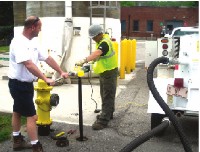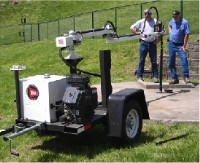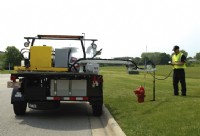Preventive Maintenance of Valves with Wachs Exercising Equipment


Two man operation with Pow-R-Drive II handleld exerciser

Mini VMT compact trailer system with ERV-750 with almost 4metres of reach and includes the powerful HPU-750 hydraulic power unit which powers the ERV and its included auxiliary hydraulic tool circuit.

VMT-1 Valve Maintenance Trailer with TM-7, ERV-750, Vacuum & water jet system
Implementing a valve management program to reduce the number of non-working valves in the system has a direct effect on the reliability of your system. The reliability of a water distribution system is measured by its ability to deliver a satisfactory level of service. Reliability is knowing the system is working correctly, and the ability to consistently deliver an acceptable quantity and quality of water at a suitable pressure with minimum interruptions, water quality impacts, inoperable valves and main breaks.
Working valves are critical components of a reliable water system. Valves are also an important component for providing reliability in the system. When there is a source of water leakage, valves are used to isolate the leak, or to make changes in the system to minimise scheduled service interruptions. In situations where water is flowing outside the pipes, the ability to identify, locate and operate the least amount of valves allows for isolation of the smallest area.
This is a key parameter in minimising the number of customers without water. It is usually when a problem occurs which requires valve interaction when the water companies realise that the valve was:
• Un-locatable
• Inaccessible
• Inoperable with available equipment
• Broken
This reactive method can result in a variety of problems from longer than necessary service interruptions to major issues caused by uncontrollable water leakage. The financial implications can be significant. Using a preventive maintenance program can reduce your long term costs in a number of ways:
• Reduced labour costs
• Reduced water loss through leak run time
• Expensive valve replacements
• Legal costs/Fines
One of the major stumbling blocks in developing and implementing a scheduled preventive maintenance program for valves is the apparent magnitude of the job. Regardless of whether the water system is small or large, the number of valves in the system and the proportion of workers available to do such preventive maintenance must be considered. If an unrealistic goal is established in the beginning, such as attempting to immediately operate all valves in the system every year, the task is probably overwhelming. Although this would be an ideal program, it may be impractical and chances are that such a program would never be continued. If, on the other hand, an achievable goal is set, it is far more likely that a preventive maintenance program will succeed.
Modest beginnings can achieve immediate results. For example, suppose two workers can be assigned to the program for 30 days each year when maintenance requirements are low. If two workers performed preventive maintenance on 15 to 25 distribution system valves a day during these 30 days, the crew would be able to locate and operate 450 to 750. Regardless of the magnitude of the overall task, that would mean that these numbers of valves have been maintained, can be located and will work when needed. This would be a significant number of valves in a smaller system or in a particular area of a larger city.
Before a program is implemented, a list of priorities should be developed so that a pilot program for valve exercising can pinpoint those areas that are more likely to have immediate problems. It might be decided to begin with the largest part of the system, based on consumption. The oldest part of the system might be judged of highest priority because these valves might not have been operated for the longest period of time. Perhaps the part of the system that serves the most critical customers, such as hospitals and industrial users, would receive the highest priority. Whatever the criteria used and regardless of how much time and manpower are available, the result will be valves that are known to function. A significant improvement in the system can be achieved immediately if the program is focused on the most troublesome areas.
The benefits from the Valve Maintenance and Exercising Program are:
• Accurate records of valve location, rotation
• Protection of community and utility investments with extended valve life
• Eventual reduction in labour
• Controlled valve repair which can be done in non-critical periods
• Immediate isolation of main breaks affecting as few customers as possible
• Confidence in the system.
Mechanising the process through the use of maintenance machines increases efficiency. Pipe locators, vacuum valve box cleanout systems and valve operating machines significantly increase the amount of work which can be achieved by reducing valve maintenance time by 50 to 60 percent or more on average.
Mechanised equipment can also help:
• Reduce safety risks
• Reduce valve damage
• Justify a valve exercising program
• Turn 3 times more valves per day versus manual wrenches
• Reduce labour requirements
• Exercise valves in hard to reach locations
• Eliminate operator fatigue and back injury
• Facilitate emergency water shut-offs.
Another positive outcome of a systematic valve maintenance program is the development of files or a computerised data base containing all the necessary information on each valve, as well as a map.
No matter what kinds of valves are installed in a system, all of them need to be operated periodically. Valves in a distribution system are too important to be allowed to sit idle with no maintenance for a number of years. This almost guarantees that they will be inoperable when needed. A practical valve maintenance program can be designed for initial implementation at a low cost and will ultimately result in cost savings for the water system and more reliable service for its customers.
Wachs UK, Tel 01606 861 423
Website: www.ehwachs.com
Published: 31st March 2010
Rachel Wormald, Managing Director at YPS Valves Ltd and Elizabeth Waterman, ...
Are you looking for industry-leading, brand independent valve and actuator ...
As can be seen from the photograph, clearly the resident birds at Bartlett ...
Howco Group has unveiled its latest £1million investment, with the ...
In 2024, Allvalves is poised for an exciting year of growth and expansion, ...
GMM Pfaudler Engineered Plastics & Gaskets are delighted to bring the ...
In the ever-evolving valve industry, GMM Pfaudler stands out for its ...
SAMSON Controls Ltd – part of the SAMSON group - a renowned leader in ...










